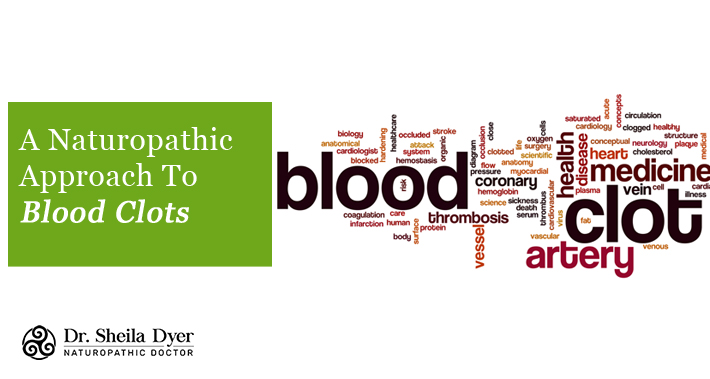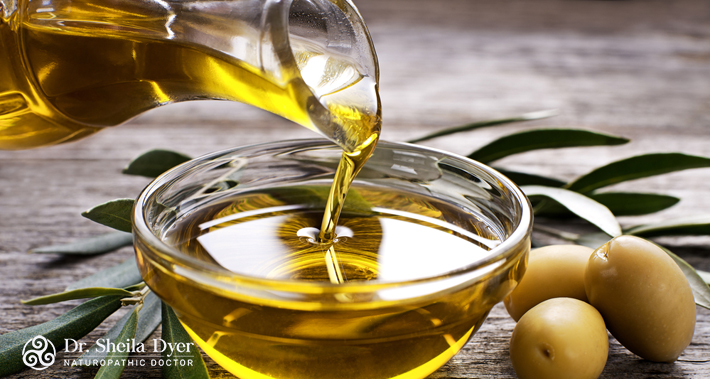You probably don’t think too much about your blood.
It’s there, flowing through your body, bringing oxygen and nutrients to your cells.
However if something goes wrong with your blood, you’ll notice.
If you have a bleeding cut, you’ll notice.
Or if you end up with a bruise, causing blood to pool under the skin, you’ll notice.
But if you have a blood clot, you may not notice or realize what is happening until it’s too late.
I’m Dr. Sheila Dyer, a naturopathic doctor in Toronto and I want to help you recognize the signs of a blood clot so you can notice them before they cause even larger problems for you.
Keep reading to learn more about the types of blood clots, and how to recognize them.
What Is A Blood Clot?
If you cut yourself, blood clotting is an important function your body performs to prevent you from losing too much blood.
However when blood clots while still in your veins, it can cause problems, and even death.
Blood clots are formed when platelets start to stick together, leading to thickened blood which can cause blockages to your bloodstream.
What Puts You At Risk Of A Blood Clot?
Some of the factors which can put someone at a higher risk of developing a blood clot include:
- Being on certain types of hormonal birth control
- Hormonal imbalances
- Age – risk increases over 65 years old
- Cancer
- Being a smoker
- Obesity
- Pregnancy
- Long periods of being sedentary
- Some forms of hormone replacement therapy, including for transgender women
Symptoms Of Different Types Of Blood Clots
Not all types of blood clots present the same way.
Let’s have a look at some of the symptoms associated with common types of blood clots.
Pulmonary Embolism
A blood clot which affects the lungs is called a pulmonary embolism.
Embolism is the name given to a clot that has traveled in the blood stream from one point to another.
A pulmonary embolism is usually a clot that started in the deep vein of the leg, was dislodged and travelled to the lungs where is got stuck.
Some signs of this type of blood clot include:
- Coughing up blood
- Shortness of breath, unrelated to exercise
- Chest pain
- Tachycardia
- Difficulty breathing
Abdominal Blood Clot
If you are experiencing severe abdominal pain, it may be a sign there is a blood clot in your abdomen.
Abdominal pain could also indicate food poisoning or a stomach virus, which cause many to visit a naturopathic IBS clinic in Toronto.
Deep Vein Thrombosis
Deep vein thrombosis (DVT) is a serious type of blood clot and occurs when there is a clot in one of the major veins, deep inside the body.
A deep vein thrombosis occurs most commonly in the lower leg.
This blood clot is serious because it can lead to a pulmonary embolism.
Common signs include:
- Warm, red, or discoloured skin
- Limb swelling
- Pain not due to injury
Blood Clot In Limbs
One of the most common locations for blood clots is in the lower leg.
This is why it is often recommended people wear compression socks on long flights – these garments are designed to help reduce swelling and maintain blood flow if you are sitting for a long period of time.
Symptoms of clots in the arms or legs include:
- Pain
- Tenderness
- Swelling
- Reddish colouring
- Warmth
It should also be noted it is rare for both arms or legs to have a clot, so if these symptoms appear in both limbs at the same time, it’s likely the cause is something else – however symptoms isolated to one arm or leg have a higher risk of being due to a clot.
Heart Attack
A blood clot which cuts off blood flow to the heart is one cause of heart attacks.
Signs of a heart attack include a heavy feeling in your chest, shortness of breath, and feeling lightheaded.
Stroke
A blood clot which cuts off blood to the brain can result in a stroke.
An easy way to remember the common signs of a stroke is the acronym “FASTER”
- F – Facial drooping
- A – Arm weakness
- S – Stability or Steadiness (loss of these)
- T – Talking, including speech impairment, or slurred speech
- E – Eyes – vision changes
- R – React – a reminder to call 9-1-1 immediately when you notice these signs
When To Seek Emergency Medical Care
Many people with blood clots experience few or no symptoms, so if you begin to exhibit signs of one, it is important to seek medical care.
Symptoms which could indicate issues with your breathing or heart function should always merit an immediate call to emergency services, no matter their cause.
These include:
- Pressure in the chest
- Sudden onset shortness of breath, not related to exercise
- Trouble breathing
- Sudden speech or vision issues
Naturopathic Solutions To Prevent Blood Clots
There are several things you can do to help reduce your chance of developing blood clots, naturally.
Let’s have a look at a few of the ways to help keep your blood flowing freely.
1. Move Your Body
Sitting for long periods of time can lead to the formation of blood clots.
This can be sitting on an airplane for hours on a long flight, or just sitting at your desk, so immersed in an important project you don’t take the time to get up and stretch.
Luckily, there is an easy fix for this one – be sure to move and stretch, regularly.
Getting up at walking around at least once every two to three hours can help keep the blood flowing.
Leg stretches, such as raising and lowering your toes and heels can help as well.
2. Stay Hydrated
When you’re dehydrated, it can lead to your blood becoming thicker, and therefore increases your risk for blood clots.
You can tell how well hydrated you are by taking a look at the colour of your pee.
If it’s a pale yellow colour, then chances are you’re well hydrated – if it’s darker, it may indicate dehydration.
Water has loads of benefits beyond staving off blood clots as well, so pour yourself a glass and drink up!
3. Eat Garlic
In addition to making your food taste great, and keeping vampires at bay, garlic may help keep your blood from clotting.
A study in the Journal of Agricultural and Food Chemistry shows evidence that garlic can help to break up platelet clusters which can lead to blood clots.
For the most benefit, crush garlic cloves to release the beneficial compounds, and eat them raw or roasted.
4. Eat Virgin Olive Oil
A 2007 study in the American Journal of Clinical Nutrition found virgin olive oil helped prevent blood clots, due to its antioxidant content.
Eating foods with healthy unsaturated fats like olive oil at least once a week was shown to help lower the risk of blood clots in obese, non-smoking adults.
5. Drink Red Wine (In Moderation!)
If you don’t already drink alcohol, we’re not suggesting you start now, however if you are one to indulge in a drink every so often, the polyphenols in red wine can help keep clots from forming.
Purple grape juice may also have the same effect, however, beware of the high levels of sugar found in many juices.
Book Your Appointment With Dr. Sheila Today
Are you worried you may be in a high risk group for blood clots?
Do you worry about developing them because you spend a lot of times on long flights, or take a medication which can increase your risk?
I’m Dr. Sheila Dyer, ND, and I can help you create a plan to ensure you’re doing everything you can to keep your risk low.
Contact my office today, to set up a consultation.
If you have questions about naturopathic medicine, or would like to start with your first consultation, contact me, and let’s book an appointment.
Dr. Sheila Dyer, ND1080 Dovercourt Rd,
Toronto, ON M6H 2X8
(416) 554-5135
► https://g.page/DrSheilaDyerNd
Dr. Sheila Dyer is a Naturopathic Doctor and a practicing registered nurse offering holistic healthcare with a scientific focus

